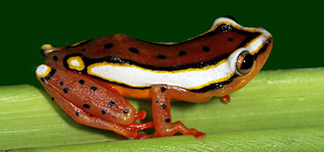Phrynobatrachus bullans Crutsinger, Pickersgill, Channing and Moyer, 2004
This species name means 'bubbling' (Latin) and refers to the often audible release of air that occurs when this frog is attempting to escape a predator.
Phrynobatrachus bullans is a medium sized (snout–vent length < 28 mm) species of puddle frog. Members of this genus are identified by the presence of a midtarsal tubercle, elongate inner metatarsal tubercle, and metatarsal tubercle. Chevron shaped glands are clearly present on the dorsum. The suite of morphological features that characterize this species include a visible tympanum, moderate to extensive webbing, and lack of digital discs. This species can be distinguished from P. natalensis, which is morpholgically very similar, by its elongate post-ocular glands and advertisement call.
The IUCN Red List (2009) categorizes this species as Least Concern in view of its wide distribution, presumed large population, and because it is unlikely to be declining fast enough to qualify for listing in a more threatened category (Moyer et al., 2004).
This species is present in the Ruaha, Tarangire, Serengeti and Rubobo Island National Parks (Moyer et al., 2004).
It is an adaptable species that is not facing any significant threats (Moyer et al., 2004).
The combination of a number of morphological features makes this species distinct, including a visible tympanum, lack of digital discs, and moderate to extensive webbing. Its elongate post-ocular glands and advertisement call distinguish it from P. natalensis.
Mitochodrial sequence data from 12S rRNA, valine-tRNA, and 16S rRNA fragment, as well as combined sequence data from mitochondrial and nuclear (RAG-1) genes indicate that P. francisci is the sister species of P. bullans (Zimkus, 2010). These two species are in turn sister taxa to the clade containing P. acridoides and P. pakenhami.
P. bullans has a broad and rounded head, resembling a slender Tomopterna (Pickersgill, 2007). It is morphologically most similar to P. natalensis but can be distinguished by its smaller size (P. bullans males up to 24 mm; P. natalensis males up to 32 mm) and different advertisement call (Crutsinger et al., 2004). This species is distinguished from P. mababiensis, P. parvulus, P. scheffleri,P. stewartae, P. ukingensis, P. uzungwensis by a visible tympanum. It is distinguished from P. acridoides, P. dendrobates, P. graueri, P. irangi, P. pakenhami, P. perpalmatus, P. rouxi, and P. versicolor by the absence of digital discs.
Dorsum colour varies from grey or brown with a dark band between the eyes and a lighter occipital patch in some specimens. A light intervertebral line is present in some specimens (50% in Pickersgill, 2007). Banding on the legs is brown, although often incomplete, and banding is also often present on the lower jaw. The venter is pale to white; males have a dark grey gular region with white asperities and lateral vocal folds. The post-ocular glands are elongate and either meeting or approaching a pair of oval scapular glands, creating the X-shaped pattern. Males have prominent light-colored asperities over the dorsum; females have aperities over the posterior of the dorsum. The tympanum is distinct and round, 50-60% of the eye diameter, and the eye diameter is approximately the snout length (Pickersgill, 2007). The nostril is closer to the snout tip than the eye. The head is approximately 37% of the snout-vent length (SVL). The tibia, foot, and femur are approximately 46%, 46%, and 43% of the SVL, respectively (Pickersgill, 2007). Webbing is moderate to extensive with 1-2 phalanges free on toe II, 2 phalanges on toe IV, and 1-2 phalanges free on toe V. Digital discs are absent. No femoral glands are present.
Phrynobatrachus bullans is a medium sized (snout–vent length < 28 mm) puddle frog species. Snout-vent length varies from 20.0-24.2 mm in males, and 22.0-27.2 mm in females (Crutsinger et al., 2004).
It was originally documented from central Tanzania in the Arusha, Tabora, and Singida regions (Crutsinger et al., 2004) and was more recently documented in Ethiopia and Kenya (Zimkus, 2008), suggesting that it may be found in additional areas within Kenya and Ethiopia. Frogs that are probably this species have also been heard in the Masai Mara Game Reserve in Kenya (Pickersgill, 2007).
For specimen locality data see:
https://spreadsheets.google.com/ccc?key=0AqWTiFSJOtfUdC04bzdGeVUydmNuUjR...
It occurs in savannahs, including in areas with long dry seasons, and breeds in flooded grassland and in pools of water with fringing vegetation. It also breeds in paddy fields, and has been found in ditches in towns (Moyer et al., 2004)
It is a common species (Moyer et al., 2004).
Females lay large clutches of small (0.8 mm in diameter) dark brown eggs within vegetation at the surface of water (Pickersgill, 2007). Eggs resemble those of P. natalensis.
